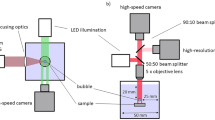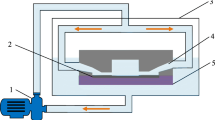Abstract
Experiments are carried out to investigate the cavitation process induced by the spill-off from material from a surface in a liquid environment. Therefore, a simplified physical model was designed which allows the optical observation of the process next to a transparent glass rod submerged in a liquid where the rod is forced to fracture at a pre-defined groove. High-speed shadow-imaging and refractive index matching allow observation of the dynamics of the cavitation generation and cavitation bubble breakdown together with the flow. The results show that the initial phase of spill-off is a vertical lift-off of the rod from the surface that is normal to the direction of pendulum impact. A cavitation bubble is immediately formed during spill-off process and grows in size until lateral motion of the rod sets in. While the rod is transported away, the bubble shrinks into hyperbolic shape and finally collapses. This process is regarded as one contributing factor to the high efficiency of hydro-abrasive wear.






Similar content being viewed by others
References
Abouel-Kasem A, Emara KM, Ahmed SM (2009) Characterizing cavitation erosion particles by analysis of SEM images. Tribol Int 42:130–136
Ashmore J, Del Pino C, Mullin T (2005) Cavitation in a lubrication flow between a moving sphere and a boundary. Phys Rev Lett 94:124501
Buravova SN (1998) Surface damage as a result of cavitation erosion. Tech Phys 43:1107–1110
Buravova SN, Gordopolov YuA (2011) Cavitation erosion as a kind of dynamic damage. Int J. Fract 170(1):83–93
Caupin F, Herbert E (2006) Cavitation in water: a review. C. R. Phys 7:1000–1017
Chen YL, Kuhl T, Israelachvili J (1992) Mechanism of cavitation damage in thin liquid films: collapse damage vs. inception damage. Wear 153:31–51
Chen H, Wang J, Chen D (2009) Cavitation damages on solid surfaces in suspensions containing spherical and irregular microparticles. Wear 266(1–2):345–348
Davis RH, Rager DA, Good BT (2002) Elastohydrodynamic rebound of spheres from coated surfaces. J Fluid Mech 468:107–119
Franc JP, Michel JM (2004) Fundamentals of cavitation. Kluwer, Dordrecht
Hengyun J, Fengzhen Z, Shiyun L, Chenzhao H (1986) The role of sand particles on the rapid destruction of the cavitation zone of hydraulic turbines. Wear 112:199–205
Huang S, Ihara A (1996) Effects of solid particle properties on cavitation erosion in solid–water mixture. J Fluids Eng 118:749–755
Joseph DD (1998) Cavitation and the state of stress in a flowing liquid. J Fluid Mech 366:367–378
Kantak AA, Davis RH (2004) Oblique collisions and rebound of spheres from a wetted surface. J Fluid Mech 509:63–81
Kedrinskii VK (1989) On relaxation of tensile stresses in cavitating liquid. In Proceedings of the 13th International congress on acoustics, Beograd, Sabac: Dragan Srnic Press 1: 327–330
Knapp RT, Daily JW, Hammitt FG (1970) Cavitation. McGraw-Hill Book Company Ed, New York
Lauterborn W (1980) Cavitation and inhomogeneities in underwater acoustics. Springer, Heidelberg
Mansoor MM, Uddin J, Marston JO, Vakarelski IU, Thoroddsen ST (2014) The onset of cavitation during the collision of a sphere with a wetted surface. Exp Fluids 55:1648
Marston JO, Yong W, Ng WK, Tan RBH, Thoroddsen ST (2011) Cavitation structures formed during the rebound of a sphere from a wetted surface. Exp Fluids 50:729–746
Mikulich V, Brücker Ch, Chaves H (2013) Study of hydrodynamic mechanisms of wire sawing. Advanced Methods and Technologies for Materials Development and Processing, September 18–20, Minsk, Belarus
Pernik AD (1966) Problems of cavitation. Sudostroenie Publishing House, Leningrad
Prokunin AN, Slavin RV (2006) Cavitation-induced particle-wall interactions in Newtonian and non-Newtonian fluids. Rheol Acta 45:348
Reiner M (1958) Rheology. Springer, Berlin
Roberts DK, Wells AA (1954) The velocity of brittle fracture. Engineering 171:820–821
Ross GR, Heideger WJ (1962) Vapor pressure of glycerol. J Chem Eng Data 7:505–507
Seddon JRT, Mullin T (2008) Cavitation in anisotropic fluids. Phys Fluids 20:023102
Washio S, Takahashi S, Murakami K, Tada T, Deguchi S (2008) Cavity generation by accelerated relative motions between solid walls contacting in liquid. Proc IMechE J Mech Eng Sci 222(C):1695–1706
Zhao K, Gu CQ, Shen FS, Lou BZ (1993) Study on mechanism of combined action of abrasion and cavitation erosion on some engineering steels. Wear 162–164:811–819
Acknowledgments
The studies of the wire sawing process that initiated the current work on cavitation were funded by the DFG in the project Br 1494/20-1. The authors gratefully acknowledge the support herein.
Author information
Authors and Affiliations
Corresponding author
Rights and permissions
About this article
Cite this article
Mikulich, V., Brücker, C. Cavitation by spall fracture of solid walls in liquids. Exp Fluids 55, 1785 (2014). https://doi.org/10.1007/s00348-014-1785-6
Received:
Revised:
Accepted:
Published:
DOI: https://doi.org/10.1007/s00348-014-1785-6




